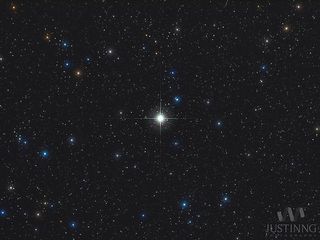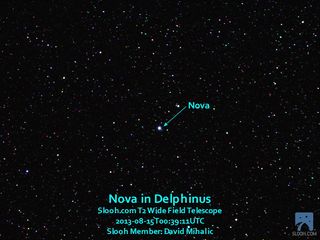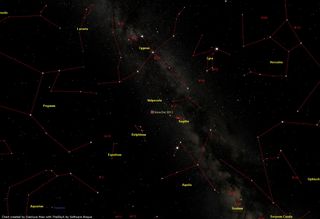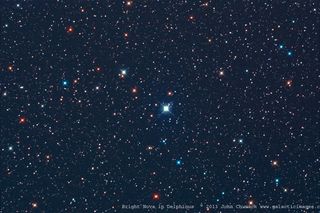New Nova Star Explosion Wows Stargazers: See It Online Today

A new star explosion in the night sky, called a nova, is captivating stargazers around the world and is now visible to the naked eye, weather and light conditions permitting. Today (Aug. 19), you can catch live views of the nova in an online webcast.
The new Nova Delphinus 2013 star explosion was discovered last week by Japanese amateur astronomer Koichi Itagaki. He spotted the nova (Latin for "new star") on Aug. 14 while observing the constellation Delphinus (The Dolphin) through a telescope.

The online Virtual Telescope Project in Italy will webcast live views of Nova Delphinus today at 4 p.m. EDT (2000 GMT). You can watch the live nova webcast on SPACE.com here, courtesy of the Virtual Telescope. [See photos and sky maps of the new nova star explosion]
"This amazing nova is getting brighter!" astrophysicist Gianluca Masi, who runs the Virtual Telescope Project in Ceccano, Italy, told SPACE.com in an email on Friday (Aug. 16). You can watch the nova webcast live directly from the Virtual Telescope Project here: http://www.virtualtelescope.eu/webtv/

A bright 'nova'
Astronomers measure the brightness of night sky objects as magnitude, in which brighter objects are given lower numbers. Negative numbers denote exceptionally bright objects, such as the moon.
When Nova Delphinus 2013 was first discovered, its magnitude was estimated to be about +6.8. That placed the nova's brightness at just beyond what can be seen with the naked eye, which is designated as a magnitude of +6.5. The nova was still visible in binoculars and telescopes, however.
Get the Space.com Newsletter
Breaking space news, the latest updates on rocket launches, skywatching events and more!
By Friday, however, the situation had changed. The nova had brightened to a magnitude +4.5, placing it within naked-eye observing range. Masi suspects Nova Delphinus' current brightness is about the maximum level it is going to reach, but that hasn't kept stargazers from marveling at the stellar spectacle.
The nova is "hard to see naked eye unless you are in a very dark sky and know exactly where to look," veteran astrophotographer and skywatcher John Chumack wrote in an email. "But this is a very bright nova, most don’t get above 8th magnitude."

Nova star explosions explained
A nova is a star explosion that scientist think occurs when a white dwarf star in a binary system strips material from its partner star, which over time triggers a massive outburst. Unlike supernovas, which are catastrophic explosions that signal the death of a star, novas do not destroy their stars. Novas are not as bright as supernovas, which can be so brilliant they can temporarily shine with the brightness of 100 billion normal stars.
Novas bright enough to be seen with the naked eye typically occur about once or twice a decade, according to Joe Rao, SPACE.com's skywatching columnist. The brightest nova within the last 50 years occurred in August 1975 when a star explosion was spotted in the constellation Cygnus (The Swan) and reached a maximum brightness of about +1.8 (the brightness equivalent of Polaris, the North Star).
Here are some tips on how to see Nova Dephinus 2013:
The nova is located inside the small constellation Delphinus, the Dolphin, which can be found near the famed Summer Triangle made by the bright stars Vega, Altair and Deneb. Delphinus is a small diamond-shaped star pattern made up of four moderately dim stars.
In late evening, Delphinus is currently visible high in the southeast sky. By midnight, local time, the constellation is about two-thirds of the way up from the southern horizon.
Editor's Note: If you snap an amazing picture of the new nova star explosion, or any other night sky view that you'd like to share for a possible story or image gallery, send photos, comments and your name and location to managing editor Tariq Malik at spacephotos@space.com.
Email Tariq Malik at tmalik@space.com or follow him @tariqjmalik and Google+. Follow us @Spacedotcom, Facebook and Google+. Original article on SPACE.com.
Join our Space Forums to keep talking space on the latest missions, night sky and more! And if you have a news tip, correction or comment, let us know at: community@space.com.

Tariq is the Editor-in-Chief of Space.com and joined the team in 2001, first as an intern and staff writer, and later as an editor. He covers human spaceflight, exploration and space science, as well as skywatching and entertainment. He became Space.com's Managing Editor in 2009 and Editor-in-Chief in 2019. Before joining Space.com, Tariq was a staff reporter for The Los Angeles Times covering education and city beats in La Habra, Fullerton and Huntington Beach. In October 2022, Tariq received the Harry Kolcum Award for excellence in space reporting from the National Space Club Florida Committee. He is also an Eagle Scout (yes, he has the Space Exploration merit badge) and went to Space Camp four times as a kid and a fifth time as an adult. He has journalism degrees from the University of Southern California and New York University. You can find Tariq at Space.com and as the co-host to the This Week In Space podcast with space historian Rod Pyle on the TWiT network. To see his latest project, you can follow Tariq on Twitter @tariqjmalik.
